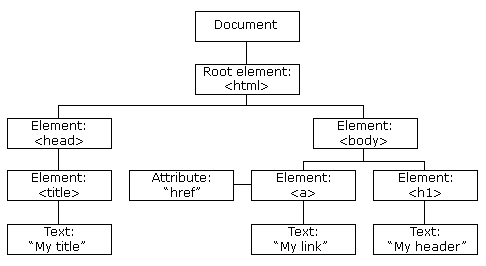|
– W3C's –
Document Object Model Specification: (DOM)
W3C Recommendation. |
|---|
| •
DOM Requirements (Version 1.0) |
– Latest version: W3C Working Group Note |
| •
Element Traversal Specification (Navigation interfaces) |
– W3C Recommendation 22 December 2008 |
| |
|
Document Object Model (DOM) - level 1 Specification - |
| • DOM Level 1 Specification |
– W3C Recommendation 1 October, 1998 |
| –
Chapter 1: (DOM) Core Level 1 | |
| –
Chapter 2: (DOM) HTML Level 1 | |
|

|
| |
|
Document Object Model (DOM) - level 2 Specification - |
| • DOM Level 2 Core Specification
(Version 1.0) | – W3C Recommendation 13 November, 2000 |
| • DOM Level 2 HTML Specification
(Version 1.0) | – W3C Recommendation 09 January 2003 |
| • DOM Level 2 Traversal and Range Specification
(Vers 1.0) | – W3C Recommendation 13 November, 2000 |
| • DOM Level 2 Views Specification
(Version 1.0) | – W3C Recommendation 13 November, 2000 |
| • DOM Level 2 Events Specification
(Version 1.0) | – W3C Recommendation 13 November, 2000 |
| • DOM Level 2 Style Specification
(Version 1.0) | – W3C Recommendation 13 November, 2000 |
 |
| |
|
Document Object Model (DOM) - level 3 Specification - |
| • DOM Level 3 Core Specification
(Version 1.0) | – W3C Recommendation 07 April 2004 |
| • DOM Level 3 Validation Specification
(Version 1.0) | – W3C Recommendation 27 January 2004 |
| • DOM Level 3 (LS)Load and Save Specification
(Version 1.0) | – W3C Recommendation 07 April 2004 |
 |
| |
|
Document Object Model (DOM) - Specification - under development - Working Draft / W3C Note |
| • DOM Level 3 Events Specification
(Version 1.0) | – Latest Published Version: under development |
| • Server-Sent Events |
– Latest Published Version: under development |
| • DOM Level 3 Abstract Schemas Specification
(Version 1.0) | – Latest version: W3C Note |
| • DOM Level 3 XPath Specification
(Version 1.0) | – Latest version: W3C Working Group Note |
| • DOM Level 3 Views and Formatting Specification
(Ver 1.0) | – Latest version: W3C Working Group Note |
| Document Object Model DOM :
Current Status |
| |
| The HTML DOM Node Tree |

The HTML DOM views a HTML document as a tree-structure.
The tree structure is called a node-tree.
All nodes can be accessed through the tree.
Their contents can be modified or deleted, and new elements can be created.
• Source:
HTML DOM Tutorial W3Schools. |
| Node Parents, Children, and Siblings |

The nodes in the node tree have a hierarchical relationship to each other.
The terms parent, child, and sibling are used to describe the relationships.
Parent nodes have children.
Children on the same level are called siblings (brothers or sisters).
• Source:
HTML DOM Tutorial © W3Schools. |
| DOM EVENTS |
 |
| • DOM Level 3 19. DOM Events,
– by Philippe Le Hégaret 2002 - W3C. |






































